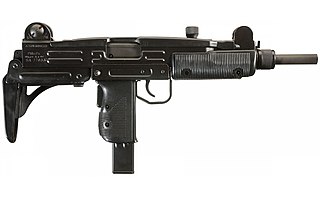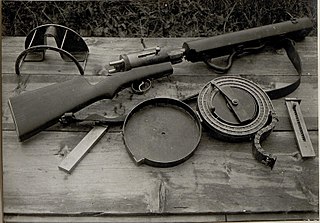Related Research Articles

A submachine gun (SMG) is a magazine-fed automatic carbine designed to fire handgun cartridges. The term "submachine gun" was coined by John T. Thompson, the inventor of the Thompson submachine gun, to describe its design concept as an automatic firearm with notably less firepower than a machine gun. As a machine gun must fire rifle cartridges to be classified as such, submachine guns are not considered machine guns.

The Uzi is a family of Israeli open-bolt, blowback-operated submachine guns and machine pistols first designed by Major Uziel "Uzi" Gal in the late 1940s, shortly after the establishment of the State of Israel. It is one of the first weapons to incorporate a telescoping bolt design, which allows the magazine to be housed in the pistol grip for a shorter weapon.

The Thompson submachine gun is a blowback-operated, selective-fire submachine gun, invented by United States Army brigadier general John T. Thompson in 1918. It was originally designed to break the stalemate of trench warfare of World War I, but early models did not arrive in time for combat.

The STEN is a British submachine gun chambered in 9×19mm which was used extensively by British and Commonwealth forces throughout World War II and post war including the Korean War. The Sten was a simple design with very low production cost for mass production to meet demand for submachine guns.

The .45 Reising submachine gun was manufactured by Harrington & Richardson (H&R) Arms Company in Worcester, Massachusetts, USA, and was designed and patented by Eugene Reising in 1940. The three versions of the weapon were the Model 50, the folding stock Model 55, and the semiautomatic Model 60 rifle. Over 100,000 Reisings were ordered during World War II, and were initially used by the United States Navy, Marine Corps, and the United States Coast Guard, though some were shipped to Canadian, Soviet, and other allied forces to fight the Axis powers.
The Lanchester is a submachine gun manufactured by the Sterling Armaments Company between 1941 and 1945. It is a copy of the German MP28/II and was manufactured in two versions, Mk.1 and Mk.1*; the latter was a simplified version of the original Mk.1, with no fire selector and simplified sights. It was primarily used by the Royal Navy during the Second World War, and to a lesser extent by the Royal Air Force Regiment. It was given the general designation of Lanchester after George Lanchester, who was charged with producing the weapon at the Sterling Armaments Company.

The Kulsprutepistol m/45, also known as the Carl Gustaf M/45 and the Swedish K SMG, is a 9×19mm Swedish submachine gun (SMG) designed by Gunnar Johansson, adopted in 1945, and manufactured at the Carl Gustafs Stads Gevärsfaktori in Eskilstuna, Sweden. The m/45 was the standard submachine gun of the Swedish Army from 1945 to 1965. It was gradually replaced in Swedish service by updated Ak 4 battle rifles and Ak 5 assault rifles. The last official user of the m/45, the Swedish Home Guard (Hemvärnet), retired it from service in April 2007.

The Moschetto Automatico Revelli-Beretta Mod. 1915 was a self-loading carbine that entered service in 1918 with the Italian armed forces. Designed as a semi-automatic carbine, the weapon came with an overhead inserted magazine, an unconventional design based on the simplicity of allowing a spent round to be replaced using assistance from gravity. The gun was made from half of a Villar-Perosa aircraft submachine gun.

The PPSh-41 is a Soviet submachine gun designed by Georgy Shpagin as a cheaper and simplified alternative to the PPD-40. A common Russian nickname for the weapon is "papasha" (папа́ша), meaning "daddy", and it was sometimes called the "burp gun" because of its high fire-rate.

The Colt 9mm SMG, also known as the Colt Model 635 or Colt M635, is a 9×19mm Parabellum submachine gun manufactured by Colt, based on the M16 rifle.

The QCW-05 is a suppressed bullpup submachine gun, manufactured and developed by the People's Liberation Army (PLA) 208 Research Institute and Jianshe Industries (Group) Corporation of Chongqing under the China South Industries Group for the People's Liberation Army Ground Force, the People's Liberation Army Special Operations Forces and the People's Armed Police. This weapon is designed for the 5.8×21mm DCV05 sub-sonic round that is also used by the QSW-06 Silenced Pistol.

The FMK-3 is a selective fire blowback-operated submachine gun of Argentinian origin designed by Fabricaciones Militares in 1974. Around 30,000 were produced for the Argentinian military by 1991.

The Smith & Wesson M76 submachine gun (SMG) was produced by Smith & Wesson from 1967 to 1974.

The name Borz is an umbrella term applied to all improvised submachine guns produced during the years of independence of the Chechen Republic of Ichkeria. It was produced in small numbers from 1992 to 1999. The initial model was based on the Armenian K6-92, which in turn was based on the PPS submachine gun.

The Carabinetta Automatica O.V.P was a submachine gun developed in Italy.

The Experimental Model 2 submachine gun was a pre–World War II Japanese experimental submachine gun chambered in the 8mm Nambu round.

The M3 is an American .45-caliber submachine gun adopted by the U.S. Army on 12 December 1942, as the United States Submachine Gun, Cal. .45, M3. The M3 was chambered for the same .45 ACP round fired by the Thompson submachine gun, but was cheaper to mass produce and lighter, at the expense of accuracy. The M3 was commonly referred to as the "Grease Gun" or simply "the Greaser," owing to its visual similarity to the mechanic's tool.

The PPS is a family of Soviet submachine guns chambered in 7.62×25mm Tokarev, developed by Alexei Sudayev as a low-cost personal defense weapon for reconnaissance units, vehicle crews and support service personnel.

The B&T APC is a family of firearms produced and manufactured by B&T of Switzerland. A unique design feature of the APC is that more than 50% of all parts are interchangeable between the different calibres.

Standschütze Hellriegel 1915 was an Austro-Hungarian water-cooled submachine gun produced during World War I in very limited prototype numbers.